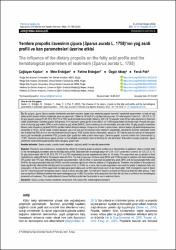Yemlere propolis ilavesinin çipura (Sparus aurata L. 1758)’nın yağ asidi profili ve kan parametreleri üzerine etkisi
Citation
KAPLAN Çağlayan,ERDOĞAN METE,ERDOĞAN FATİME,AKTAŞ Özgür,PAK Faruk Yemlere propolis ilavesinin çipura (Sparus aurata L. 1758)’nın yağ asidi profili ve kan parametreleri üzerine etkisi. Su Ürünleri Dergisi 39, no.2(2022): 151 - 159. Doi: 10.12714/egejfas.39.2.09Abstract
Bu çalışma, çipura (Sparus aurata) diyetlerinde yem katkı maddesi olarak artan oranlarda propolis ilavesinin hematolojik parametreler ve balık eti yağ asitleri profili üzerine etkilerini araştırmak amacıyla yapılmıştır. Ortalama 12,04±0,01 g ağırlığındaki çipuralar, 10 hafta boyunca 0 (kontrol), 1,25, 2,5, 5, 10, 20 g/kg propolis (kısaca P1,25; P2,5; P5; P10 ve P20) ilaveli diyetlerle beslenmiştir. Deneme, 400 L’lik 18 polyester tanka 50’şer balık eklenerek üç tekerrürlü olarak yürütülmüştür. Deneme grupları %45 protein, %17 yağ içeren yemle günde iki kez (09:00 ve 17:00) doyana kadar elle beslenmiştir. Propolis takviyesi, balık eti doymuş yağ asitleri (SFA) ve tekli doymamış yağ asitleri (MUFA) üzerine herhangi bir etki etmemiştir, bununla birlikte 10 g/kg propolis ilavesinden itibaren çoklu doymamış yağ asidi (PUFA) içerikleri önemli düzeyde artmıştır. Dolayısı ile yemlere propolis ilavesi, balık eti toplam yağ asidi kompozisyonunu etkilemiştir (p <0,05). Sonuç olarak, propolis takviyesi, çipura eti yağ asidi kompozisyonunun kalitesini iyileştirmiştir. Denemenin sonunda balıklardan alınan kan örneklerinde RBC (kırmızı kan hücrelerindeki eritrosit sayısı), HGB (kanda bulunan hemoglobin sayısı) ve HCT (kanda bulunan eritrosit ve hemoglobin sayısı) gibi hematolojik parametreler P20 grubunda diğer gruplardan daha yüksek bulunmuştur. Deneme grupları arasında anlamlı fark bulunmamıştır (p >0,05). Yemlerine propolis ilavesi çipura yavrularının hematolojik parametreleri üzerine herhangi bir etki etmemiştir. Elde edilen sonuçlar propolisin, çipura yemlerinde kullanılabilme potansiyeline sahip olduğunu göstermiştir. This study was carried out to investigate the effects of increasing levels of propolis addition as a feed additive in seabream (Sparus aurata) diets on the hematological parameters and the fish fatty acids profile. Seabream with an average weight of 12.04 ± 0.01 g were fed 0 (control), by 1.25, 2.5, 5, 10, 20 g/kg (abbreviated with P1.25; P2.5; P5; P10 and P20 respectively) propolis supplemented diets for 10 weeks. The experiment was conducted in three replications by adding 50 fish to 18 polyester tanks of 400 L. The trial groups were fed twice daily (09:00 and 17:00) by hand to satiation with feed containing 45% protein and 17% lipid. Although the propolis supplementation had no effect on seabream saturated fatty acids (SFA) and monounsaturated fatty acids (MUFA), the polyunsaturated fatty acid (PUFA) contents increased significantly after the addition of 10 g/kg propolis. Therefore, the addition of the propolis to feeds significantly affected the total fatty acid composition of fish (p <0.05). As a result, the propolis supplement improved the quality of seabream fatty acid composition. At the end of the experiment, hematological parameters such as RBC (erythrocyte count in red blood cells), HGB (hemoglobin count in blood) and HCT (erythrocyte and hemoglobin count in blood) in blood samples taken from fish were found to be higher in P20 group than the other groups. There was no significant difference between the experimental groups (p > 0.05). The addition of the propolis to their feed did not have any effect on the hematological parameters of seabream. The results obtained showed that the propolis has the potential to use in seabream feeds.


















